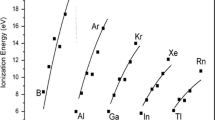Abstract
This review is a deep study of the Bray’s 1921 paper that reported the observation of the first periodic reaction in homogeneous phase. The paper obtained a general indifference by other chemists and some opposition due to the fact that it seemed to contradict the second Principle of Thermodynamics. Only after the work by Ilya Prigogine and coworkers in the mid-1960s, oscillating chemical reactions in the homogeneous phase have been studied intensively, but Bray died in 1946.


Similar content being viewed by others
Notes
Asa Leonard Caulkins (1887–1972) obtained an M.A. degree in chemistry in 1916 at the University of California at Berkeley, discussing the thesis: “A Study of the Reactions Involving Hydrogen Peroxide, Iodine and Iodate Ion”. Following this, he moved to Stockton, CA where he taught chemistry and math at Stockton High School.
Alfred J. Lotka (1880–1949) is known almost exclusively as the founder of mathematical demography and for his studies ranging from epidemiology to bibliometrics. But Lotka started out as a chemist, receiving the B.Sc from University of Birmingham in 1901. Then he perfected the thermodynamic and kinetic approach to chemical reactions. In 1910 he published his first paper on a scheme of three consecutive reactions that led to periodic damped oscillations of intermediate (J. Phys. Chem. 1910, 14, 271–274). In 1920 Lotka published a second scheme of consecutive reactions with first and second step were autocatalytic (J. Am. Chem Soc. 1920, 42, 1595–1599). The focal point of the first scheme was the assumption that the second step was autocatalytic for the intermediate. Lotka pointed out “that no chemical reaction is known which follows this scheme and that the case considered was suggested by the consideration of matters outside the field of physical chemistry”.
Herman Alfred Liebhafsky (1905–1982) was born in Zwittau, Austria-Hungary (now Svitavy, Czech Republic), went to the United States in 1912, and became a naturalized American in 1921. He earned a Bachelor of Science degree from Texas A. and M. College, 1926; a Master of Sciences from the University of Nebraska, 1927; and a Doctor of Philosophy from the University of California at Berkeley, 1929. He was an instructor of chemistry, UC Berkeley, 1929–1934, and a chemist at General Electric Company, Schenectady, 1934–1967, serving as a manager of the electrochemical branch, 1964–1967. Liebhafsky was a professor of chemistry at Texas A. and M. University, 1967–1972, and professor emeritus, 1972–1982.
References
Pacault A, Perraud J-J (1997) Rythmes et Formes en Chimie. Presses Universitaires de France, Paris
Hildebrand JH (1951) William Crowell Bray, 1879–1946: a biographical memoir. National Academy of Sciences, Washington, DC, p 24
Bray WC (1915) Laboratory manual of general chemistry, 1st edn. Lederer, Street & Zeus Co., Berkeley, CA
Bray WC (1921) A periodic reaction in homogeneous solution and its relation to catalysis. J Am Chem Soc 43:1262–1267
Rice FO, Reiff OM (1927) The thermal decomposition of hydrogen peroxide. J Phys Chem 31:1352–1356
Bonhoeffer KF (1948) Über periodische chemische Reaktionen I. Z Elektrochem 52:24–29
Chance B, Greenstein DS, Higgins J, Yang CC (1952) The mechanism of catalase action. II. Electric analog computer studies. Arch Biochem Biophys 37:322–339
Duysens LN, Amesz J (1957) Fluorescence spectrophotometry of reduced phosphopyridine nucleotide in intact cells in the near-ultraviolet and visible region. Biochem Biophys Acta 24:19–26
Prigogine I, Lefever R (1967) Symmetry breaking instabilities in dissipative systems II. J Chem Phys 48:1695–1700
Prigogine I (1961) Introduction to thermodynamics of irreversible processes, 2nd edn. Interscience, New York
Liebhafsky HA, Wu LS (1974) Reactions involving hydrogen peroxide, iodine, and iodate ion. V. Introduction to the oscillatory decomposition of hydrogen peroxide. J Am Chem Soc 96:7180–7187
Sharma KR, Noyes RM (1976) Reactions involving hydrogen peroxide, iodine, and iodate ion. V. Introduction to the oscillatory decomposition of hydrogen peroxide. J Am Chem Soc 98:4345–4361
Treindl L, Noyes RM (1993) A new explanation of the oscillations in the Bray-Liebhafsky reaction. J Phys Chem 97:11354–11362
Stanisavljev DR, Milenković MC, Mojović MD, Popović-Bijelić AD (2011) Oxygen centered radicals in iodine chemical oscillators. J Phys Chem A 115:7955–7958
Stanisavljev DR, Milenković MC, Popović-Bijelić AD, Mojović MD (2013) Radicals in the Bray-Liebhafsky oscillatory reaction. J Phys Chem A 117:3292–3295
Pejić N et al (2016) Dynamic transitions in the Bray-Liebhafsky oscillating reaction. Effect of hydrogen peroxide and temperature on bifurcation. Reac Kinet Mech Cat 118:15–26
Author information
Authors and Affiliations
Corresponding author
Additional information
Publisher's Note
Springer Nature remains neutral with regard to jurisdictional claims in published maps and institutional affiliations.
This review is an improvement of the first part of a paper appeared on J. Chem. Educ. 2017, 94 (2), 195-201.
Rights and permissions
About this article
Cite this article
Cervellati, R. William Crowell Bray and the discovery of the first periodic homogeneous reaction in 1921. Reac Kinet Mech Cat 135, 1139–1146 (2022). https://doi.org/10.1007/s11144-021-02019-3
Received:
Accepted:
Published:
Issue Date:
DOI: https://doi.org/10.1007/s11144-021-02019-3




